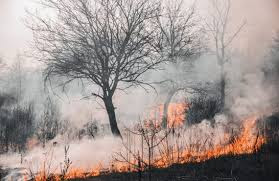Deforestation in Sri Lanka
Deforestation is one of the major environmental problems in Sri Lanka. Forests play a major role in maintaining the carbon cycle. Carbon dioxide is the main gas that contributes to the greenhouse effect. It has the ability to absorb more heat than other gases in the atmosphere. During photosynthesis, plants clean the air by absorbing carbon dioxide from the atmosphere and releasing oxygen. Therefore, forests can also be referred to as reservoirs that store carbon dioxide, and if the forest cover is removed, all the carbon dioxide stored there will be released back into the atmosphere. Thus, it is clear that the destruction will lead to an imbalance in local and regional climatic conditions and to enhance the greenhouse effect.
Sri Lanka is an island nation of 65,525 km2 in the Indian Ocean. Sri Lanka is currently one of the 34 Biodiversity Hotspots in the world. This means that Sri Lanka has a large number of endemic plant and animal species found nowhere else in the world, and at least 70% of the natural habitat inhabited by this species has already been lost.
It is simply the vast expanse of forest that is overgrown with massive vegetation, creating a variety of canopies and sometimes canopies. The well-being of the environment in which we live depends on the balanced existence of the living and inanimate components of that system. Accordingly, natural forests are essential for the survival of wildlife. Any country should have at least 35% forest cover, but unfortunately only about 20% currently exist in Sri Lanka.
As a developing country, “wood based industries” play an important role in the Sri Lankan economy. The sale of timber to increase revenue can be seen as a major part of the national economy. According to Central Bank of Sri Lanka statistics, the Sri Lankan forest sector contributed about 15 billion rupees to the national economy in 1998, accounting for 2% of GDP (GDP). The forest cover in Sri Lanka was 70% in the early 1800s but gradually decreased to 29% in 2015. According to the Food and Agriculture Organization of the United Nations (FAO), Sri Lanka has been the fourth country in the world to lose 1% of its primary forest cover every year since late 2005. The problem of deforestation due to such reasons has grown in Sri Lanka.
During the Portuguese, Dutch and English colonial periods, forests were cleared for the development of commercial agriculture. By the time the British left the country about 100 years later, the forest cover had dropped to about 50% of what it was before. Also, after Sri Lanka became an independent state in 1948, timber production increased and became a medium for fuel. Furthermore, economic and industrial development accelerated deforestation as a result of massive development projects such as the Mahaweli Project, which was launched to irrigate large areas in the Northeast. The project has rehabilitated about 2430 km of forest.
Deforestation had to be done not only for development projects but also for security reasons. Accordingly, during the Civil War, the Sri Lankan government took steps to strategically clear the forest to provide less cover for the enemy.
Over the past 100 years, Sri Lanka's natural forest cover has decreased from 80% to 16% as a percentage. By the end of the 19th century, more than 80% of the country was covered by forests, but by the beginning of the 20th century this rate had dropped to 70%.
The main causes of deforestation in Sri Lanka are agriculture, gem mining, settlement and infrastructure development projects, commercial agro-enterprises and forest fires for chena cultivation. Also, wildfires, which are currently prevalent in the tropical dry forests of Sri Lanka, can be cited as another major factor contributing to deforestation in the country. When a forest fire breaks out, many acres of vegetation are destroyed. For almost a decade, wildfires have been reported in various parts of the country almost every year, causing damage to soil fertility, biodiversity and ecosystems, as well as the continuing decline in the quality of some forests.
With the increase in population and human needs in Sri Lanka, the impact on forests has increased. Deforestation, in line with population growth, has had a number of adverse effects on the climate, the environment and the lives of the people as described above. Therefore, the following measures have been taken to protect the forest resources and wildlife. That is,
- Maintaining National Reserves and Sanctuaries
- Establishment of afforestation projects
- Adoption of forest conservation strategies (wetland conservation, mangrove conservation)
- Encouraging community participatory cultivation
- Tree planting and forest productivity enhancement
- Educating the public about the adverse effects of deforestation
- Establishment of environmentally sensitive zones
In addition, the Government of Sri Lanka, in collaboration with international environmental organizations, has taken steps to address this problem by establishing national parks, reserves and sanctuaries over the years. For example, the Sinharaja Forest Reserve was designated a UNESCO World Heritage Site in 1988.
From the above it is clear that with the increase in population of Sri Lanka and the consequent increase in human needs, the impact on the forests has also increased. As a result, the climate, the environment and the lives of the people are undergoing various changes. In addition, deforestation has caused natural disasters such as floods and landslides in Sri Lanka. Although a number of steps have been taken to reduce the risk of disaster, due to impracticality or shortcomings in their implementation, the outcome is yet to be seen.








Great post anu 👍❤️
ReplyDeleteGreat.🔥
ReplyDeletegreat one bro ❤
ReplyDelete😍❤️
ReplyDeleteGreat 🌼
ReplyDelete💗
ReplyDelete❤
ReplyDeleteGreat one ❤️
ReplyDeletevaluable it❤️💚
ReplyDeleteWe must protect the environment. A very important one. 👌
ReplyDelete❤️❤️
ReplyDelete❤️❤️❤️
ReplyDelete